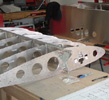


random user submitted photo
jump starting- Bob Mika
6 posts
• Page 1 of 1
jump starting- Bob Mika
Hey guys,
I know this has been briefly touched on in the past. I would like to make a jump starting/charging set up like Bob Mika has. I have not seen the intricate details but have seen the pics and the exterior of his plane up in Arkansas. He posted a picture blog but I am a little unsure of some things and don't know often he visits the site. The picture blog appears to have an aluminum 1/8" plate that I think is wrapped in fiberglass with two blocks on either end that have the battery cables attached to. He then screws one bolt into each block through the cowl and attaches the charger/starter to the bolts.I just don't know how he attaches the cable to the nut on the 1/8" plate for the bolt to attach to. If it is solely wrapped in fiberglass I would think that it would not stand up very well so I am wondering if there is something I am missing. Anyone know how he did it? Bob you around?
Mark Whiddon
I know this has been briefly touched on in the past. I would like to make a jump starting/charging set up like Bob Mika has. I have not seen the intricate details but have seen the pics and the exterior of his plane up in Arkansas. He posted a picture blog but I am a little unsure of some things and don't know often he visits the site. The picture blog appears to have an aluminum 1/8" plate that I think is wrapped in fiberglass with two blocks on either end that have the battery cables attached to. He then screws one bolt into each block through the cowl and attaches the charger/starter to the bolts.I just don't know how he attaches the cable to the nut on the 1/8" plate for the bolt to attach to. If it is solely wrapped in fiberglass I would think that it would not stand up very well so I am wondering if there is something I am missing. Anyone know how he did it? Bob you around?
Mark Whiddon
Mark Whiddon
T25 Aero Estates
Sonex N889AP
jabiru 3300 solid lifter
T25 Aero Estates
Sonex N889AP
jabiru 3300 solid lifter
- tx_swordguy
- Posts: 184
- Joined: Wed Dec 06, 2017 10:11 pm
Re: jump starting- Bob Mika
Another option that has been used by quite a few people is to fit an Anderson plug.

Mount one firmly on the engine mount just under the cowl surface with a fairly small access hole in the cowl.
Peter

Mount one firmly on the engine mount just under the cowl surface with a fairly small access hole in the cowl.
Peter
- peter anson
- Posts: 558
- Joined: Thu Jul 31, 2014 2:34 am
- Location: Mount Macedon, Australia
Re: jump starting- Bob Mika
I used a method I got from hints for home builders video. I cut a short extension cord in half and stripped the outside insulation back a few inches. Stripped the inner wires and attached ring terminals that fit my battery posts. The other part of the cord was attached to a board holding copper posts. On the cord attached to the battery I secured the plug near the cowling exit where I could reach it without removing the cowl. To use, I plug the cords together and attach the charger to the copper posts. pretty simple to do and no cowl modification.
Bill Larson
N861SX
Sonex, polished, tail wheel, Generation 4 Jabiru 3300
N861SX
Sonex, polished, tail wheel, Generation 4 Jabiru 3300
- wlarson861
- Posts: 499
- Joined: Wed Dec 05, 2012 11:41 pm
Re: jump starting- Bob Mika
Mark,
Overall I'm not a fan of jump starting our airplanes as a means to get back into the air (like say to continue along your way on an XC trip). Although getting the engine running easily is very convenient, it has several potential unintended consequences you should be aware of. The two biggest of those are 1) the lack of any significant capacity inside your battery, and 2) the alternator is going to work extra-hard to recharge the battery.
Battery capacity is important because that's your emergency reserve to keep your instruments working if the alternator should decide to quit. This plays into reason 2) where the alternator has to work overtime to recharge a deeply-discharged battery. The recharging will place a significant strain on the alternator and voltage regulator as the battery "demands" all the current the charging system can provide (especially lithium or Odyssey batteries, which can accept huge charge in-rush currents). After jump starting, the voltage regulator will run hot under the increased load, and if there are other sources of stress in the system (e.g. the voltage regulator has dirty or corroded electrical contacts, the regulator body is already heat soaked from sitting, or the regulator doesn't get very good cooling due to its mounting location), the voltage regulator may just self-destruct under the heat stress (e.g. burn up).
This creates a follow-on problem that has to be fixed, where the battery is still deeply discharged and now the regulator is dead as well. A safer and simpler method is to carry a battery charger along with you, and add a quick connection lead to the battery that can be accessed either with the cowl off, or the through an convenient cowling access door. It's certainly not as convenient having to wait for a couple hours to recharge the battery, and it might cause you to blow you timeline on an XC trip, but it's safer in the long run, and works more reliably.
Jeff
Overall I'm not a fan of jump starting our airplanes as a means to get back into the air (like say to continue along your way on an XC trip). Although getting the engine running easily is very convenient, it has several potential unintended consequences you should be aware of. The two biggest of those are 1) the lack of any significant capacity inside your battery, and 2) the alternator is going to work extra-hard to recharge the battery.
Battery capacity is important because that's your emergency reserve to keep your instruments working if the alternator should decide to quit. This plays into reason 2) where the alternator has to work overtime to recharge a deeply-discharged battery. The recharging will place a significant strain on the alternator and voltage regulator as the battery "demands" all the current the charging system can provide (especially lithium or Odyssey batteries, which can accept huge charge in-rush currents). After jump starting, the voltage regulator will run hot under the increased load, and if there are other sources of stress in the system (e.g. the voltage regulator has dirty or corroded electrical contacts, the regulator body is already heat soaked from sitting, or the regulator doesn't get very good cooling due to its mounting location), the voltage regulator may just self-destruct under the heat stress (e.g. burn up).
This creates a follow-on problem that has to be fixed, where the battery is still deeply discharged and now the regulator is dead as well. A safer and simpler method is to carry a battery charger along with you, and add a quick connection lead to the battery that can be accessed either with the cowl off, or the through an convenient cowling access door. It's certainly not as convenient having to wait for a couple hours to recharge the battery, and it might cause you to blow you timeline on an XC trip, but it's safer in the long run, and works more reliably.
Jeff
- sonex1374
- Posts: 605
- Joined: Thu Mar 27, 2014 1:02 am
Re: jump starting- Bob Mika
Thanks guys, Jeff I understand the hesitancy of jump starting and am not advocating it for a regular way of operation. I would always if possible be charging it but I would like to have cables big enough to jump if an emergency came up. This stems from when I met you at Reklaw couple yrs ago. It was so cold my avid flyer battery did not have the reserve power to crank fast enough to fire it off. After cranking several times it was even worse. I got it going with a jumper box. I had a solar charger on it but 1.5 Watts was not enough to get the battery to fire in 28 degree weather. I did get a bigger battery after that, but the idea of a way to jump if needed still appeals to me. Thanks for the suggestions
Mark
Mark
Mark Whiddon
T25 Aero Estates
Sonex N889AP
jabiru 3300 solid lifter
T25 Aero Estates
Sonex N889AP
jabiru 3300 solid lifter
- tx_swordguy
- Posts: 184
- Joined: Wed Dec 06, 2017 10:11 pm
Re: jump starting- Bob Mika
Hi Everyone,
It looks like I have been causing trouble again.
Just to be clear, the bolts protruding from my cowling are for battery charging/maintenance only. If you have seen them during a fly in you will notice my solar charger plugged into them. I also use a battery maintainer in the hangar some of the time. The system seems to work good for me.
I have jumped the aircraft twice using this system but do not recommend it. Those two times were just to get back home.
I hope this makes everything clear.
Bob (guilty as "charged") Mika
It looks like I have been causing trouble again.
Just to be clear, the bolts protruding from my cowling are for battery charging/maintenance only. If you have seen them during a fly in you will notice my solar charger plugged into them. I also use a battery maintainer in the hangar some of the time. The system seems to work good for me.
I have jumped the aircraft twice using this system but do not recommend it. Those two times were just to get back home.
I hope this makes everything clear.
Bob (guilty as "charged") Mika
-

planeolbob - Posts: 136
- Joined: Mon Aug 08, 2011 11:51 am
6 posts
• Page 1 of 1
Who is online
Users browsing this forum: No registered users and 82 guests







